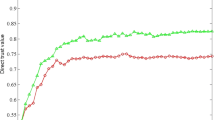Abstract
There are many smart applications evolved in the area of the wireless sensor networks. The applications of WSNs are exponentially increasing every year which creates a lot of security challenges that need to be addressed to safeguard the devices in WSN. Due to the dynamic characteristics of these resource constrained devices in WSN, there must be high level security requirements to be considered to create a high secure environments. This paper presents an efficient multi attribute based routing algorithm to provide secure routing of information for WSNs. The work proposed in this paper can decrease the energy and enhances the performance of the network than the currently available routing algorithm such as multi-attribute pheromone ant secure routing algorithm based on reputation value and ant-colony optimization algorithm. The proposed work secures the network environment with the improved detection techniques based on nodes’ higher coincidence rates to find the malicious behavior using trust calculation algorithm. This algorithm uses some QoS parameters such as reliability rate, elapsed time to detect impersonation attacks, and stability rate for trust related attacks, to perform an efficient trust calculation of the nodes in communication. The outcome of the simulation show that the proposed method enhances the performance of the network with the improved detection rate and secure routing service.






Similar content being viewed by others
References
Bao, F., Chen, I. R., Chang, M., & Cho, J. H. (2012). Hierarchical trust management for wireless sensor networks and its applications to trust-based routing and intrusion detection. IEEE Transactions on Network and Service Management, 9(2), 169–183.
Butun, I., Morgera, S. D., & Sankar, R. (2013) A survey of intrusion detection systems in wireless sensor network. IEEE Communications Surveys & Tutorials, 16(1): 266–282.
Kapetanidou, I. A., Sarros, C.-A., & Tsaoussidis, V. (2019). Reputation-based trust approaches in named data networking. Future Internet, 11, 241. https://doi.org/10.3390/fi11110241.
Iván, G.-M., & Lacuesta, R. (2017). ABS-TrustSDN: An agent-based simulator of trust strategies in software-defined networks. Security and Communication Networks. https://doi.org/10.1155/2017/8575842.
Ganeriwal, S., & Srivastava, M. B. (2004). Reputation-based framework for high integrity sensor networks. In Proceedings of the 2nd ACM Workshop on Security of Ad Hoc and Sensor Networks (SASN ’04), Washington, pp. 66–77.
Yan, Z., Zhang, P., & Vasilakos, A. V. (2015). A security and trust framework for virtualized networks and software-defined networking. Security and Communication Networks.
Shaikh, R. A., Jameel, H., Auriol, J. B., & Lee, H. (2009). Groupbased trust management scheme for clustered wireless sensor networks. IEEE Transactions on Parallel and Distributed Systems, 20(11), 1698–1712.
Zeng, B., & Dong, Y. (2016). An improved harmony search based energy-efficient routing algorithm for wireless sensor networks. Applied Soft Computing, 41, 135–147.
Mei, J. P., Yu, H., Liu, Y., Shen, Z., & Miao, C. (2014). A social trust model considering trustees’ influence. In: H. K. Dam, J. Pitt, Y. Xu, G. Governatori, & T. Ito (Eds.) PRIMA 2014: Principles and Practice of Multi-Agent Systems. PRIMA 2014. Lecture Notes in Computer Science, vol 8861. Springer, Cambridge.
Liney, M. (2018) AIS Reputation Mechanism in MANET, Conference: 28th International Telecommunication Networks and Applications Conference (ITNAC).
Mustafa, M. M., & Parthasarathy, V. (2018). A design and implementation of polling TDMA with a comparative analysis with time division multiple access for sporting application. Wireless Personal Communications, 26 (3), 1897–1904. https://doi.org/10.1007/s11276-018-1879-9.
Mustafa, M. M., & Parthasarathy, V. (2021). A Clustering TDMA and code block binding algorithms to enhance the node energy and security of the network. Wireless Personal Communications, 116, 767–775. https://doi.org/10.1007/s11277-020-07737-w.
Momani, M., Challa, S., Alhmouz, R. B. N. W. S. N.: Bayesian network trust model for wireless sensor networks. In Proceedings of the Mosharaka International Conference on Communications, Computers and Applications (MIC-CCA 2008), Amman, Jordan, 8–10 2008, pp. 110–115.
Gupta, N., & Singh, S. N. (2016). Wormhole attacks in MANET. In 2016 6th International Conference—Cloud System and Big Data Engineering (Confluence), pp. 236–239.
Parker, J., Undercoffer, J., Pinkston, J., & Joshi, A. (2004) On intru-sion detection and response for mobile ad hoc networks. In:IEEE International Conference on Performance, Computing, and Communications.
Salim, D., & Iqbal, E. (2015). Adaptive trust threshold strategy for misbehaving node detection and isolation. IEEE Trustcom/BigDataSE/ISPA.
Sheltami, A., Basabaa, A., Shakshuki, E. (2014) A3ACKs: Adaptivethree acknowledgments intrusion detection system for MANETs. Journal of Ambient Intelligence and Humanized Computing, 1–10.
Jhaveri, H., Patel, S. J., & Jinwala, D. C. (2012). Improving route discovery for AODV to prevent blackhole and grayhole attacks in MANETs. INFOCOMP Journal of Computer Science, 11 (1), 1–12.
Wei, Z., Tang, H., Yu, F. R., Wang, M., & Mason P 2014 Security enhancements for mobile adhoc networks with trust management using uncertain reasoning. IEEE Transactions on Vehicular Technology, 63(9), 4647–4658.
Feroz Khan, A.B., Anandharaj, G. (2019). A cognitive key management technique for energy efficiency and scalability in securing the sensor nodes in the IoT environment: CKMT. SN Applied Sciences, 1(12).
Feroz Khan, A. B., Anandharaj, G. (2020). AHKM: An improved class of hash based key management mechanism with combined solution for single hop and multi hop nodes in IoT. Egyptian Informatics Journal.
Feroz Khan, A. B., Anandharaj, G. (2020). A Multi-layer Security approach for DDoS detection in Internet of Things. International Journal of Intelligent Unmanned Systems ahead-of-print (ahead-of-print).
Author information
Authors and Affiliations
Corresponding author
Ethics declarations
Conflicts of interest
The authors declare no conflict of interest.
Ethical approval
This article does not contain any studies with human participants or animals performed by any of the authors.
Additional information
Publisher’s note
Springer Nature remains neutral with regard to jurisdictional claims in published maps and institutional affiliations.
Rights and permissions
About this article
Cite this article
Feroz Khan, A.B., Anandharaj, G. A Cognitive Energy Efficient and Trusted Routing Model for the Security of Wireless Sensor Networks: CEMT. Wireless Pers Commun 119, 3149–3159 (2021). https://doi.org/10.1007/s11277-021-08391-6
Accepted:
Published:
Issue Date:
DOI: https://doi.org/10.1007/s11277-021-08391-6




